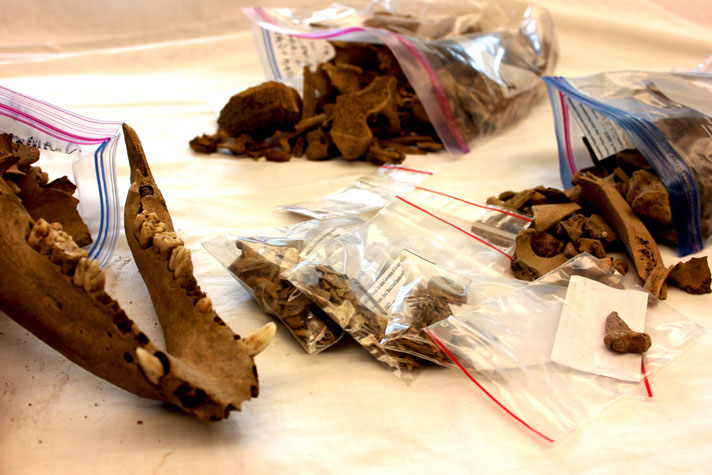Digging Jacksonville – February 2016
The Southern Oregon University Laboratory of Anthropology (SOULA) excavations at the Jacksonville Chinese Quarter Site not only resulted in the recovery of thousands of household artifacts, but also tens of thousands of fragments of bird, fish, and animal bones—that’s over 30 pounds of bone alone! These remains include mammal bones from domesticated and wild animals such as pig, goat, sheep, cow, bear, and deer, bird bones including, chicken, turkey, and duck, and fish remains from locally available and exotic fish species. The detailed analysis of all of this food, combined with the cleavers, dishes, and cooking wares will tell the story of what the occupants of our little house in the Jacksonville Chinese Quarter were cooking and eating and how this was affected by the availability of local and traditional foods.
SOULA was recently awarded a Heritage Commission Grant from the Oregon Heritage, Oregon Parks and Recreation Department, which will allow us to delve into a full-scale analysis of the faunal material from the Chinese Quarter Site. Due to the specialization of this type of analysis and the time and money that is required to do it, often collections are left with only a brief overview of the faunal material. The State’s investment in our project will allow for the specialized analysis needed, and shows that the importance of the Jacksonville Chinese Quarter site is recognized on a statewide level.
The Heritage Commission Grant will fund a variety of tasks with the following goals in mind: allow us to gain a comprehensive understanding of what locally-available animal species were being utilized in the cuisine of the Chinese immigrants in Jacksonville, what exotic species were being imported to the site, and how these foods were prepared at mealtime by the Chinese immigrants of Jacksonville. Understanding what people ate helps us understand what life was like for Chinese individuals living in 19th Century Jacksonville. What was comfort food to them? What local foods were available? What did they import from China? The final project goal is to create a comparative collection of faunal specimens related to the historic-era cuisine with an emphasis on Chinese import foods. This collection will not only help us in the identification needed to support this analysis, but it would be housed at SOU and made available for future scholars and students. We are excited about the opportunity to conducts this important project, and look forward to our next update—stay tuned!
The excavations in the Jacksonville Chinese Quarter were funded by the City of Jacksonville and the Oregon Department of Transportation.

 Katie Johnson is a staff archaeologist at the Southern Oregon University Laboratory of Anthropology. Katie will be directing the analysis of the several thousand animal and fish bones recovered from the Jacksonville Chinese Quarter Site. You can reach SOULA by contacting Chelsea Rose at rosec@sou.edu and follow SOULA on
Katie Johnson is a staff archaeologist at the Southern Oregon University Laboratory of Anthropology. Katie will be directing the analysis of the several thousand animal and fish bones recovered from the Jacksonville Chinese Quarter Site. You can reach SOULA by contacting Chelsea Rose at rosec@sou.edu and follow SOULA on